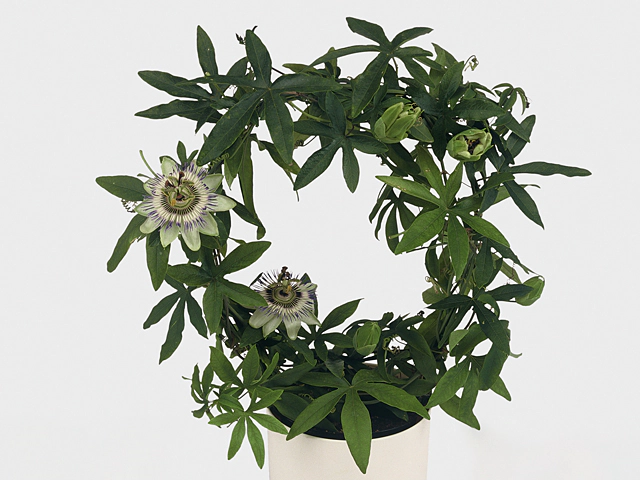Passiflora caerulea

| Fruit type | Berry |
| Leaf type | Foliage leaf |
| Winter hardness | Limited (USDA-zone 8) |
| Flower color | Blue-medium violet blue-094B; Green-light green-142C |
| Structure (tissues) | Subshrubby/semi-shrubby |
| Plant, growth type | Climbing |
| Leaf colour, pattern | Bicolored |
| Flower color distribution | Multi-colored; Bicolored |
| Toxicity (if consumed) | Fairly |
The Passion Flower, scientifically known as Passiflora caerulea, is a beautiful plant that belongs to the Passifloraceae family. It is commonly known for its striking flowers and unique fruit. This plant is native to South America and is cultivated worldwide for its ornamental value and medicinal properties.
One of the most distinguishing features of the Passion Flower is its vibrant flowers. The flower color ranges from shades of blue to medium violet-blue, creating a stunning visual display. The flowers also have a green hue, adding a touch of uniqueness to their appearance. The multi-colored and bicolored distribution of the flower colors make the Passion Flower truly captivating.
The Passion Flower is a climbing plant, with a subshrubby or semi-shrubby growth type. It has foliage leaves that are bicolored, adding a beautiful pattern to the plant. The leaves are green on the upper side and light green on the lower side, creating an interesting contrast. This foliage adds to the overall attractiveness of the Passion Flower.
In terms of fruit, the Passion Flower produces small berries. These berries are edible but should be consumed in moderation as the plant does possess some level of toxicity. The toxicity level is fairly low, but it is always advisable to exercise caution and avoid large quantities of consumption.
The Passion Flower has a limited winter hardness and can typically survive in USDA-zone 8 or warmer regions. This means that it may require protection or special care in colder climates to ensure its survival during the winter months.
Apart from its visual appeal, the Passion Flower also holds medicinal benefits. It has been used in traditional medicine for various purposes, including easing anxiety and promoting relaxation. The plant contains certain compounds that are believed to have calming effects on the nervous system, making it a popular choice for herbal remedies.
In conclusion, the Passion Flower is a stunning plant that graces gardens and landscapes with its vibrant flowers and unique fruit. Its climbing growth type and bicolored foliage leaves make it a visually appealing addition to any space. While the plant does possess some toxicity, its medicinal benefits and ornamental value make it a popular choice among gardening enthusiasts. So, if you are looking for a beautiful and versatile plant, consider adding the Passion Flower to your collection.
Market availability index by month:
| Jan. | Feb. | Mar. | Apr. | May | Jun. | Jul. | Aug. | Sep. | Oct. | Nov. | Dec. |
|---|---|---|---|---|---|---|---|---|---|---|---|
| 1 | 1 | 2 | 3 | 4 | 3 | 1 | 1 | 1 | 1 | 1 | 1 |